Learn all the secrets, tips and tricks to make the BEST Slow Cooker Bone Broth recipe that is filled with so much gelatin, it is guaranteed to jiggle like Jell-O! Hydrating, healing, and nourishing, it requires minimal effort and will reward you with a richly flavored, gelatinized broth you can use for cooking or sipping straight out of a bowl. Yum!
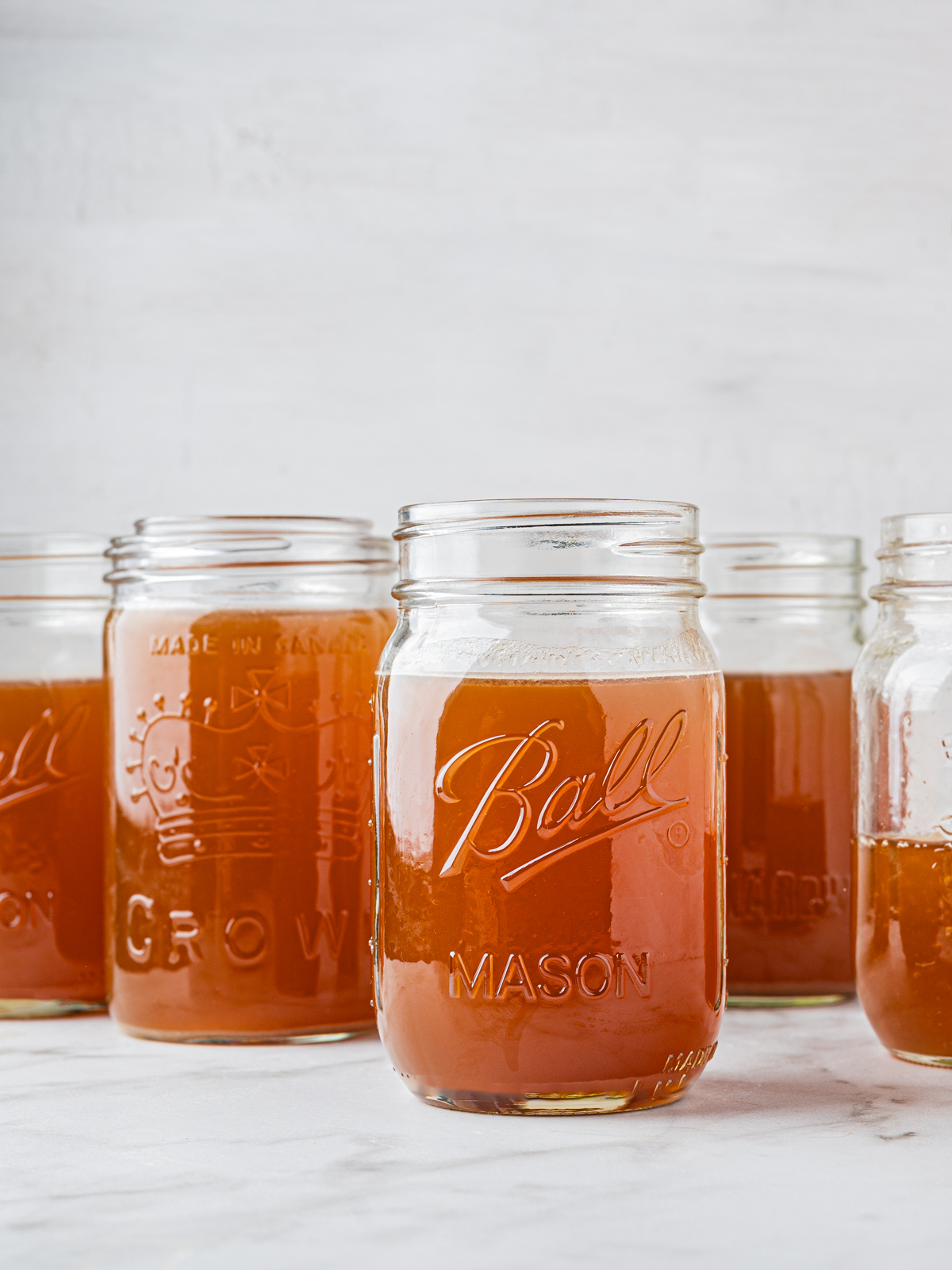
It’s flu season and it’s cold weather season which means it’s most definitely also bone broth season. So grab some chicken bones and your slow cooker, my friends, because we are about to make the easiest, best bone broth your lips have ever touched.
I’m talking about the jiggly kind, the one with the prized gelatinous liquid filled with rich, savory flavor that revives the dead. You can make it with leftovers bones or bones you buy from the butcher such as chicken backs, necks, wings and drumsticks. Chicken feet, if you can find them (or handle them 😬) are great for gelatin-producing broth.
- What Is Bone Broth?
- Is Bone Broth Healthy?
- What Is The Difference Between Bone Broth, Stock Or Regular Broth?
- Why Is A Gelatinous Broth Such A Big Deal?
- What If My Broth Doesn’t Gel?
- Reasons To Make Bone Broth In A Slow Cooker
- Recipe Ingredients And Notes
- What Are The Best Chicken Bones To Use?
- What Are The Best Vegetables To Use?
- How To Make Slow Cooker Bone Broth
- Tips For Making The Absolute Best Bone Broth
- How To Use Bone Broth
- More Frequently Asked Questions
- Storage Tips
- 5 sensational salad recipes, just for you
- Slow Cooker Bone Broth
Best of all, this fail-proof slow cooker bone broth recipe offers a dump-and-go, forget-it for-hours method that is hard to beat. Sure, nowadays it’s easy to find artisanal bone broth made by small-batch suppliers, and many are truly wonderful. However, I’m usually disappointed with the somewhat bland flavor not to mention how outrageously expensive they are for the minuscule amount you get.
Even if you’ve never made a homemade broth, I can assure you making this bone broth is painless, much easier than you think and the result will delight you.
Lastly, I must give you a heads up. This post is long. It covers just about everything you need to know about bone broth, including some myths that may surprise you. If you’re just here for the recipe, you know the drill; click on the “Jump to Recipe” button above and it will take you straight to the recipe card. Now let’s make some jiggly bone broth!
What Is Bone Broth?
Simply put, bone broth is a stock made from simmering mostly bones and ligaments with little to no meat at a low temperature for a really long time. Typically 18-48 hours! Bone broth can be made using chicken, beef, pork, lamb bones. The longer cooking time frame allows for the bones to break down, thus extracting more nutrients from the bones and producing a very rich and delicious broth.
In this post we are making chicken broth. Chicken bones are easier to find (or save from your chicken meals) and generally less expensive. I also find chicken bone broth to be more versatile since beef broth has a stronger flavor which may limit its application.
Is Bone Broth Healthy?
Bone broth may have become a huge wellness trend over the past few years, but our ancestors have been extolling its praises for centuries.
Scientifically, however, there is little proof whether bone broth is as healthy as touted. In fact, the amount of vitamins and minerals found in bone broth are much lower than previously believed, particularly if made without the addition of vegetables.
So why is bone broth so often referred to as natural penicillin, liquid gold, fountain of youth, miracle broth, medicine food, etc? Well, without diving in too deep, bones are rich in protein. Collagen is a protein found in bones which, consequently, will be extracted into the broth.
When you digest collagen, your body gets two important amino acids, glycine and proline. These amino acids are crucial for rebuilding collagen which our bodies are often lacking, particularly in a western diet.
These are among some of the health benefits attributed to bone broth:
- Heals Your Gut: Bone broth is also a valuable provider of the amino acid glutamine which plays an important role in maintaining the integrity of the gut lining.
- Promotes healthier skin, hair, teeth, and nails: Collagen in bone broth provides building blocks for your body to produce healthy skin, hair, teeth and nails.
- Strengthens Joint Health: Collagen and other amino acids increase the connective tissue around joint cartilage. Bone broth also has glucosamine and chondroitin, a potent combination used to treat joint pain and arthritis.
- Boosts immune system: The anti-inflammatory properties of certain compounds in bone broth may help boost the immune system.
- Improves mental health: The amino acid glycine has been linked with helping calm the nervous system.
But even if it wasn’t beneficial for any of these things, I would still be cooking up batches of bone broth. Not only is great for cooking all kinds of food, but it feels wonderfully restorative and comforting if you’re feeling under the weather.
What Is The Difference Between Bone Broth, Stock Or Regular Broth?
Stock is made with animal bones that generally do not contain meat and cook for a long time. Regular broth uses bones with meat still on them along with vegetables and aromatics and cooks for a shorter time.
Bone broth is a stock, but the bones do not contain meat and are cooked for a very long time, anywhere from 16-72 hours.
Stocks tend to have a richer, deeper flavor due to the amount of bones used and the longer cooking time. They will also likely produce a broth that gels when chilled due to the amount of gelatin extracted from the bones.
Why Is A Gelatinous Broth Such A Big Deal?
Gelled bone broth is often considered a sign of a well-made and nutrient-rich broth. If the broth has gelled (once chilled in the fridge), it means the collagen was successfully broken down into gelatin that resembles Jello-O.
This “Jell-O broth” is prized because both collagen and gelatin have been linked with supporting digestion and overall gut health by reducing intestinal inflammation as well as healthier skin, bones and joints.
If you follow this recipe, along with all my tips, I can guarantee you will have a broth that is so gelled once you chill it, it will jiggle like Jello-O.
What If My Broth Doesn’t Gel?
We all seem to make a big hoopla about a gelled broth, myself included. However, it is important to know that even if your broth didn’t gel, it is still perfectly fine to use.
If your broth didn’t gel, it’s likely because the gelatin was too diluted. This happens if you used too much water, didn’t cook it long enough, or didn’t have enough bones with cartilage. So it may not be as rich, but it will still be delicious, full of nutrients, and perfectly fine to use. Especially as a base for soups.
Reasons To Make Bone Broth In A Slow Cooker
- SET IT AND FORGET IT: A broth that is simmering on the stovetop should not be left unattended for hours and hours. The slow cooker solves this problem and can just simmer away low and slow without having to constantly check on it.
- GENTLE COOKING: Bone broth should never come to a rapid boil or it will get cloudy and potentially bitter. In a slow cooker, the cooking is very gentle, but maintains a consistent bubbling simmer which almost guarantees it will gelatatanize.
- RICH FLAVOR: The low and slow cooking process in a slow cooker allows the flavors to meld and intensify. This results in a rich, deeply flavorful broth.
- NO EVAPORATION: In a slow cooker, the broth cooks covered which means the liquid does not evaporate and you won’t have to be adding more water. Make sure your lid is on properly if leaving it unattended to cook for a long time.
- YIELDS A LARGE QUANTITY: Even if your slow cooker isn’t huge, you will get a decent amount of broth because you can fill it to the top and there is no moisture lost while it cooks.
Recipe Ingredients And Notes
To make this slow cooker bone broth, you will need:

- Chicken bones: See section below for what bones I recommend to use.
- Vegetables and herbs: To me a great tasting bone broth is made with the addition of vegetables and herbs. They also add more nutrition to the broth which is never a bad thing. See section below on what vegetables I recommend.
- Water
- Peppercorns: Adding peppercorns is optional but I always have them on hand so I throw some in. Black peppercorns, in particular, contain a compound called piperine, which has been associated with potential digestive benefits. Piperine may enhance nutrient absorption and improve digestion by stimulating the release of digestive enzymes. Peppercorns have been used in traditional medicine and cooking for centuries. Many traditional recipes, including bone broth, incorporate peppercorns for their flavor and potential health benefits.
NOTE: I used to always add apple cider vinegar to my stocks/broth because it allegedly helped extract the collagen from the bones. These claims have been disproven, or at least not proven, so I no longer add it.
What Are The Best Chicken Bones To Use?
Depending on the size of your slow cooker, you will need 3 to 4 pounds of chicken bones to make bone broth. Unlike when I make regular chicken broth, I rarely use a whole chicken or meaty bones to make my bone broths.
I like to use a combination of collagen-rich chicken pieces such as feet, backs, drumsticks and wings. I buy these from butchers or at my local farmers market. A whole chicken carcass is great to use, but you should add other pieces as well to be sure you get a rich broth.
I never throw away leftover bones from chicken meals I’ve made. Once I have pulled off the meat from the bones, I throw the bones into freezer-safe containers. These will make great additions to any broth.
I know chicken feet are gross, but they are the best bones for making chicken bone broth because they are full of cartilage and collagen. I have gotten over my squeemishness and stock up on said feet whenever I find them. But not gonna lie, if any rise to the top of the pot, it makes me want to run for the hills 🙃
What Are The Best Vegetables To Use?
Many recipes will tell you that adding vegetables to your homemade bone broth is optional, but I always add them. Adding vegetables and aromatics makes the broth even more nutritious and flavorful.
It’s also a great way to clean out your fridge, using vegetable scraps that can be saved from the compost. Just don’t go overboard or you may not leave enough room for the bones and water.
If possible, use organic vegetables and herbs to make your bone broth. They will have less pesticides and toxins than conventional vegetables. Organic carrots are relatively inexpensive to buy. Farmer’s markets will almost always have vegetables that are labelled “not sprayed” but will be less expensive than organic.
These are my favorite vegetables and herbs to use for making bone broth (or any stock):
- Onions
- carrots
- celery
- parsley, dill, bay leaves, and/or thyme
- Garlic
How To Make Slow Cooker Bone Broth
Straining the broth may be the only bit of work involved in making bone broth, and even that takes only 5 minutes or so. If you don’t have a large fine mesh strainer, you may want to scoop out some of the solids with a slotted spoon, or spider skimmer, before straining it.
Here’s a step-by-step overview of the recipe. Full instructions and measurements can be found in the recipe card below.
Step 1: Place all the bones in the slow cooker followed by the vegetables, bay leaves and peppercorns (if using).
Step 2: Add enough water to cover everything (I like to go up to 1-inch from the top). Cook on low for at least 18 hours and up to 24 hours. Once ready, unplug your crockpot.

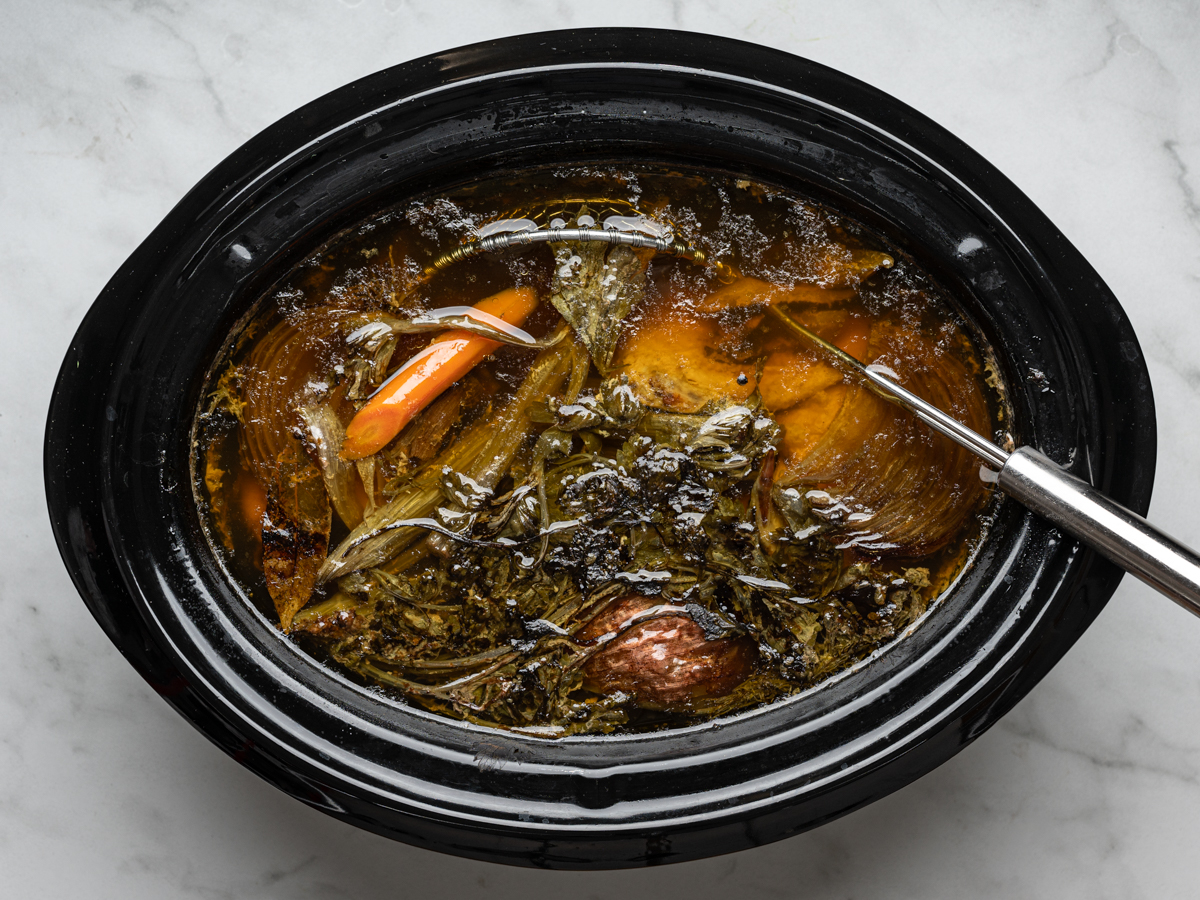
Step 3: Place a fine mesh strainer over a large bowl or pot. Using oven mitts if necessary, pour the entire contents of broth and bones over the strainer into the bowl. Once all the broth has drained out of the solids, you can discard them.
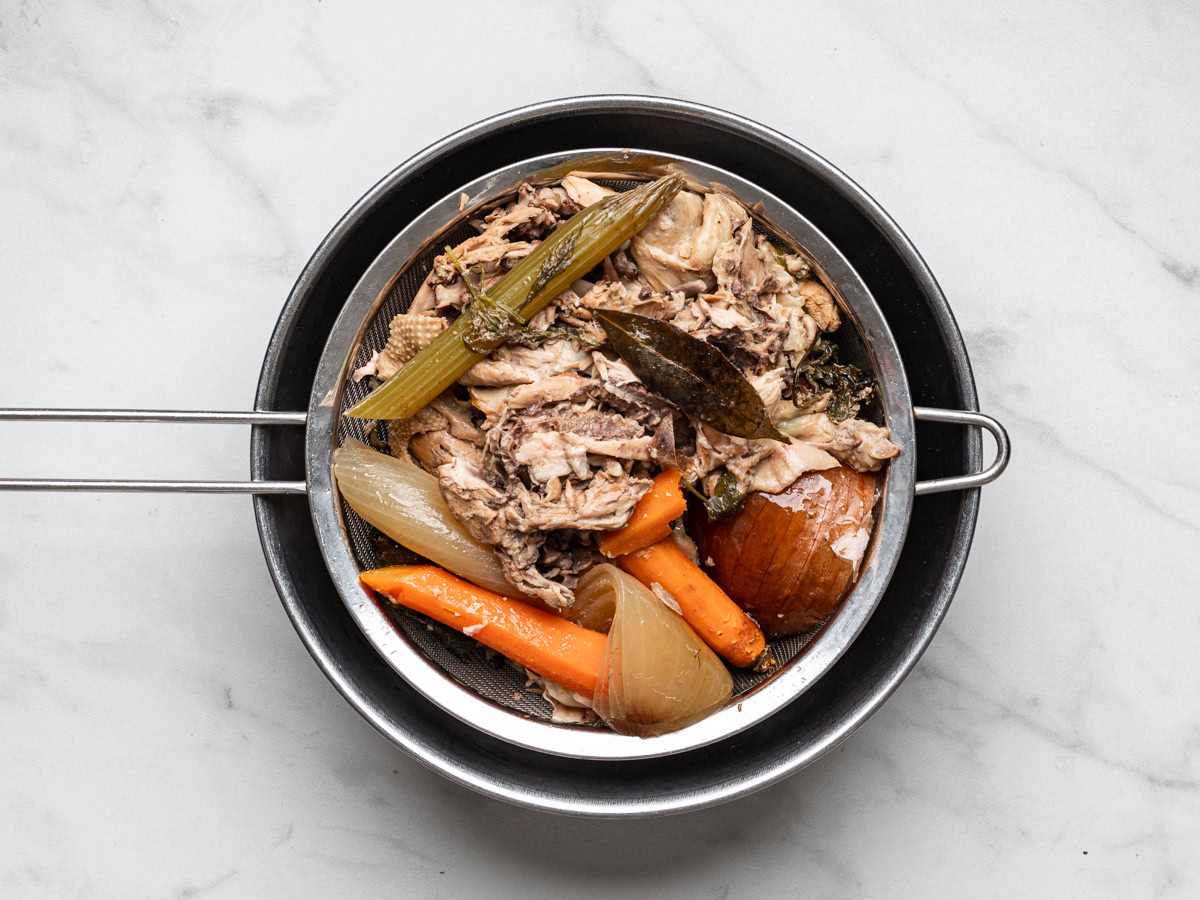
Step 4: If I’m using the broth right away, I refrigerate it in a large pot. Once broth has chilled, you can remove some, or all of the layer of fat that formed on top. (I like to leave just a little). If storing for later use, transfer broth to jars or containers of your choice, and place in the refrigerator or freeze. Alternatively, you can store the broth in jars before removing the fat, freeze or refrigerate it, and remove the fat when ready to use. See storing tips below.
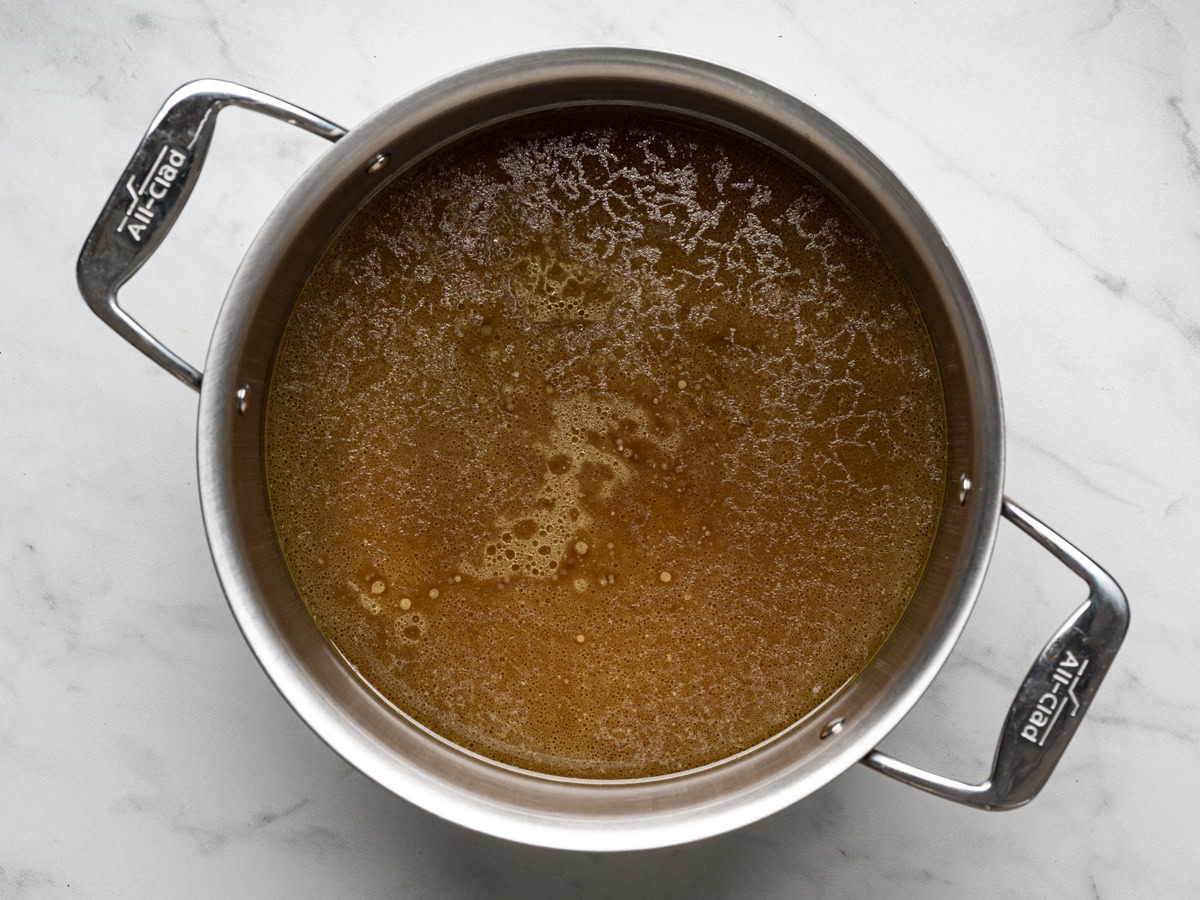




Tips For Making The Absolute Best Bone Broth
DON’T SKIMP ON THE AMOUNT OF BONES. If you’re adding chicken feet, which contain loads of collagen, you can get away with less of the other bones. Otherwise, make sure you have enough bones to come up to about 2/3 of a 6-quart slow cooker insert.
USE COLD WATER: Start with cold water to slowly extract flavors and nutrients from the bones. This helps release gelatin, which gives the broth its body.
INCLUDE VEGETABLES: Add aromatic vegetables like onions, carrots, and celery for depth of flavor. You can also include leeks, and other aromatic herbs.
USE A FINE MESH STRAINER. A fine mesh sieve will ensure all the fine particles are strained out from your finished bone broth. If you don’t have one that is large enough to hold all the solids as you strain, use a spider strainer to remove remove the solids from your pot before straining in the fine mesh strainer.
How To Use Bone Broth
There are many wonderful uses for your bone broth. Here’s a few suggestions:
- As a base for soup
- Use it in any recipe that calls for broth such as risotto, soups, short ribs, chilis and stews
- Drink it straight out of a bowl or mug
- Use it to cook grains such as quinoa, rice, farro, etc.
- As a base for making gravy
More Frequently Asked Questions
WHAT IF I WANT TO USE BEEF BONES? You can absolutely use beef bones to make slow cooker bone broth. If using beef bones, it best to roast them first to extract more flavor and prevent any funky taste in your broth. Place the bones on a sheet pan and roast in 450ºF preheated oven until golden-brown, about 25-30 minutes.
DO I NEED TO ROAST THE CHICKEN BONES? Many bone broth recipes recommend roasting beef bones to make them more flavorful and to get rid of potential bitter flavors beef bones release. I have not found any benefit to roasting chicken bones so I never do.
SHOULD I ADD SALT TO THE BONE BROTH WHILE IT COOKS? I never do. Particularly if storing it for later, it is best to add the amount of salt needed as you use it.
SHOULD I SKIM THE LAYER OF FAT OFF THE CHILLED BONE BROTH? The fat is not only full of flavor, but nutrients as well. I wouldn’t leave all the fat in, especially if you’re planning on sipping the broth from a mug becausue it could definitely taste too greasy. But I highly recommend you don’t remove all of it, your broth will be more flavorful and nutritious. Extra tip: Save whatever fat you skim off. It’s great to use for roasting or sautéing veggies, searing meat, or as a cooking fat in general. I save it in small ziplock bags and freeze for up to 3 months.
WHY IS MY BROTH A DIFFERENT COLOR THAN YOURS? Sometimes my bone broth is light-golden IN color and sometimes it is a deeper orange-brown like you see in these photos. The color of your bone broth will vary depending on the bones you use, how long you cook the broth, and the vegetables and herbs you add (if any).
SHOULD I PEEL THE VEGETABLES? I try and to use organic carrots so I never peel them. As for the onions and garlic, I like to remove any outer skin that looks dirty but leave the rest of the skin on. The onion skin adds lovely flavor to the broth and will later be discarded when the broth is strained.
CAN I COOK BONE BROTH FOR LESS THAN 18 HOURS? You can get away with cooking bone broth in the slow cooker for about 12 hours. If doing so, cook the broth on HIGH for 1 to 2 hours, then lower it to LOW for the rest of the cooking time. This ensures the broth gets hot enough to really cook down the bones, and it will also cut down on a bit of the cooking time. If you aren’t going to be around to adjust the temperature at the beginning, you can switch it to high for 1 to 2 hours during the middle or the end of the cooking time, instead.
IS THE BROTH SUPPOSED TO STAY GELLED? No. If your bone broth has a high collagen/gelatin content, it will gelatinize when refrigerated. However, as soon as you heat the broth, it will turn to liquid again.
HOW MUCH BROTH WILL I GET? If using a 6-quart slow cooker, you should be able to get about 3 quarts of broth. However, this will depend on how many bones and vegetables you add.

Storage Tips
TO STORE: Allow your bone broth to cool then store in airtight containers in the refrigerator for 4 to 5 days.
TO FREEZE: Bone broth will freeze beautifully for up to 6 months. My favorite containers to freeze broth in are these 1-cup, or 2-cup silicone souper cubes. Once the broth is frozen, I transfer it to ziplock bags or freezer-safe containers.
I avoid freezing the broth in ziplock bags after a few too many punctured and I lost my prized broth. Glass jars are great but you have to be careful not to fill them too much or they could explode in your freezer, no bueno. Good quality glass jars will also reduce the risk of the glass cracking. See this post on how to freeze liquids in glass jars.
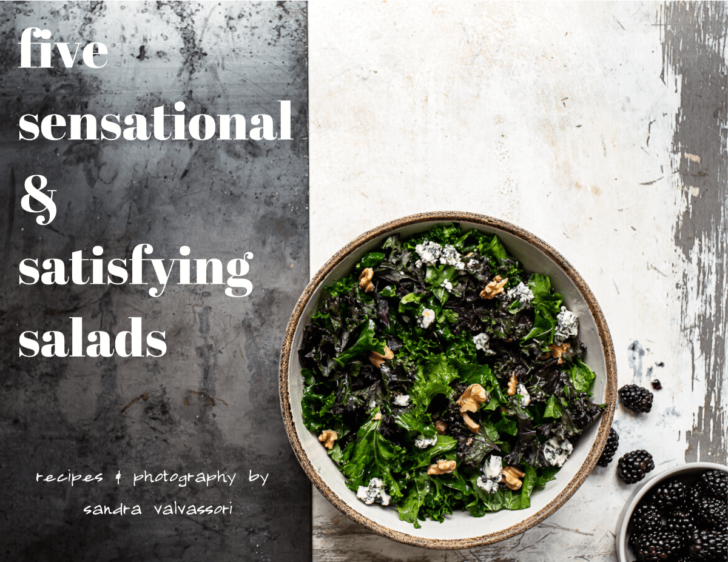
5 sensational salad recipes, just for you
Join to receive the free e-cookbook.
Soups You Will Love With Bone Broth
I hope you love this Slow Cooker Bone Broth recipe. If you make it, please leave a comment and star rating at the bottom of the page so I know how you liked it. Thank you!
Slow Cooker Bone Broth

Ingredients
- 3-4 lbs chicken bones (see notes)
- 1 large yellow onion cut in quarters (leave skins on)
- 2 carrots chopped in half
- 2 celery stalks cut in thirds
- 1 small head of garlic top sliced off (or 2-3 garlic cloves)
- 10-12 sprigs Italian flat leaf parsley
- 8 sprigs dill (or thyme)
- 2 bay leaves
- 10-12 black peppercorns optional
- 12 cups water (see notes)
Instructions
- Place the chicken bones in the slow cooker followed by the onion, carrots, celery, garlic, parsley, dill (or thyme), bay leaves and peppercorns (if using).
- Cover with water and cook on low for 18 to 24 hours. Once ready, unplug your crockpot.
- Place a fine mesh strainer over a large bowl or pot. Using oven mitts if necessary, pour the entire contents of broth and bones over the strainer into the bowl. Once all the broth has drained out of the solids, you can discard them.
- Transfer broth to jars or containers of your choice, and place in the refrigerator to chill. Once broth has chilled, remove some, or all of the fat cap layer that formed on top. (I like to leave some). See storing tips in notes.
Notes
- Chicken bones: I like to use a combination of collagen-rich chicken pieces such as feet, backs, drumsticks and wings. A whole chicken carcass is great to use, but you should add other pieces as well to be sure you get a rich broth.
- Water: You want the water to come up to 1-inch from the top of your slow cooker. If you can’t fit at least 12 cups of water, remove a few veggies to get enough water so you get plenty of broth.
- To store: Allow your bone broth to cool then store in airtight containers in the refrigerator for 4 to 5 days.
- To freeze: Bone broth will freeze beautifully for up to 6 months. My favorite containers to freeze broth in are these 1-cup, or 2-cup silicone souper cubes. Once the broth is frozen, I transfer it to ziplock bags or freezer-safe containers. Glass jars are great for freezing but make sure to read this post to avoid any shattered glass mishaps.


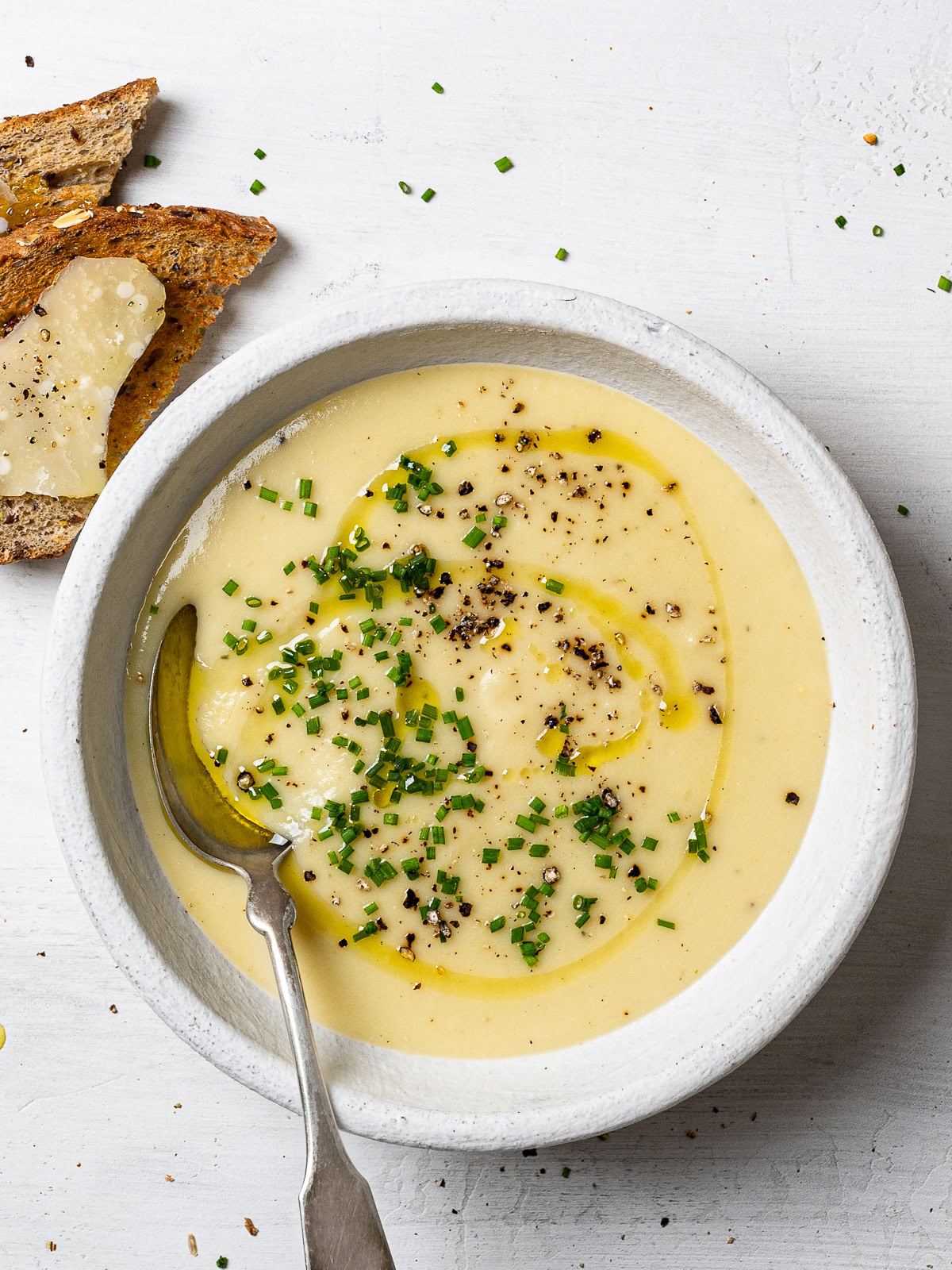
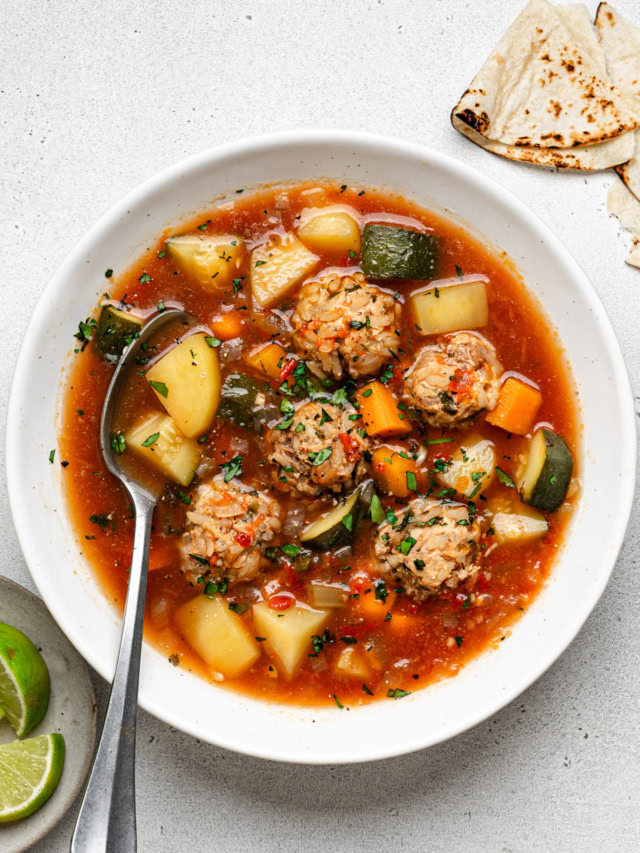

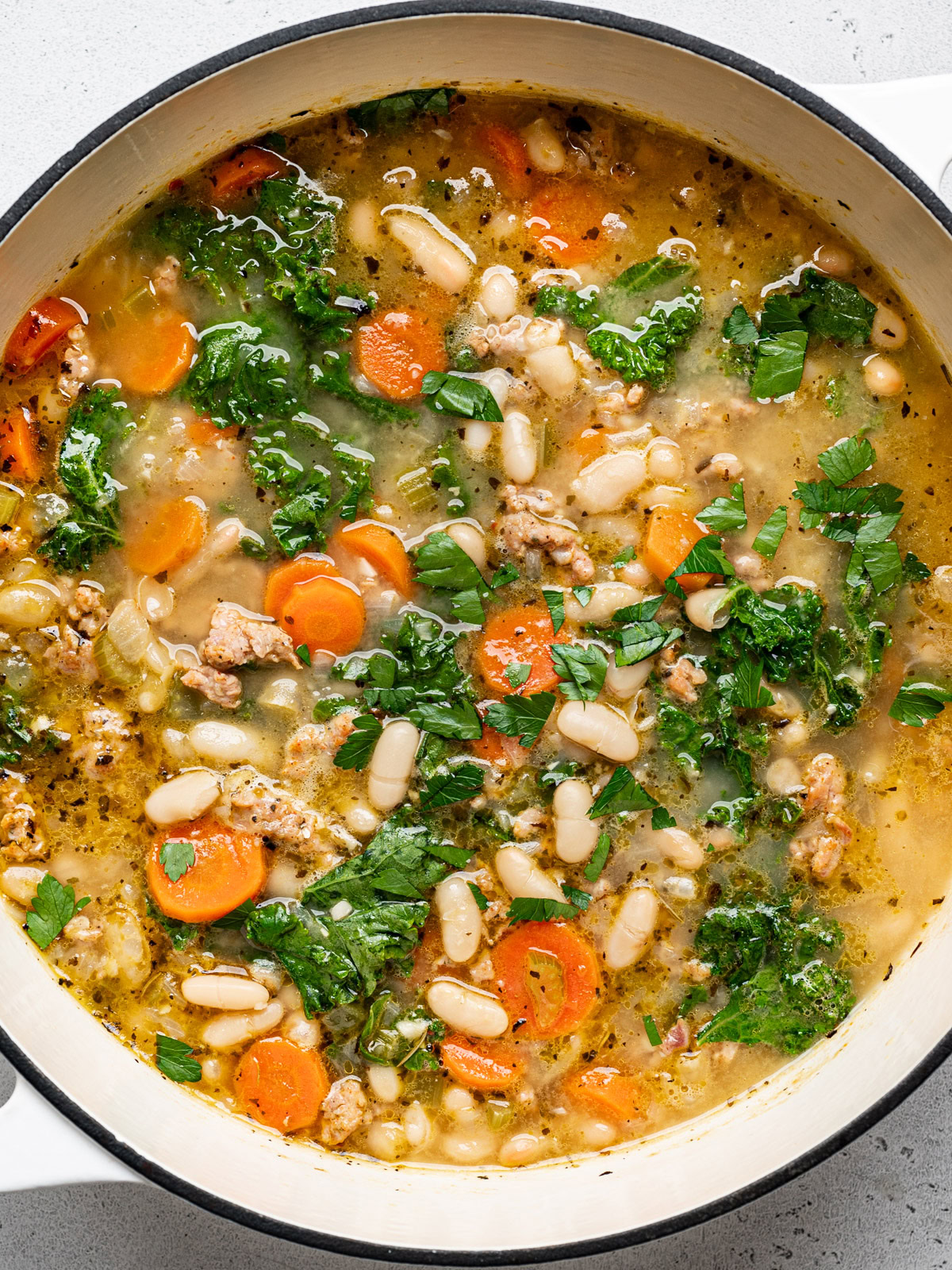
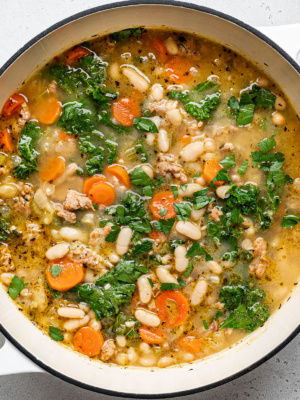
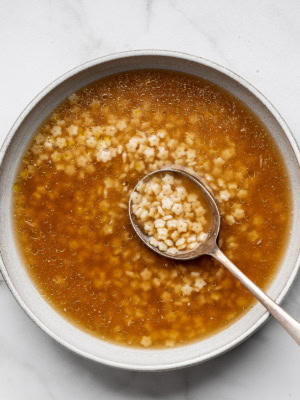

Join the Conversation